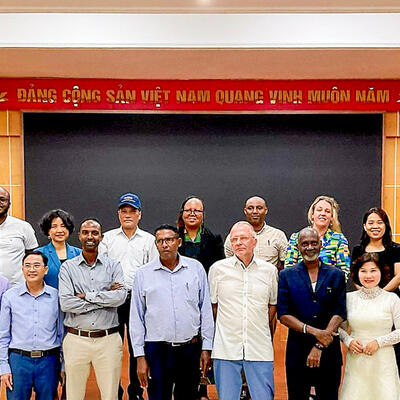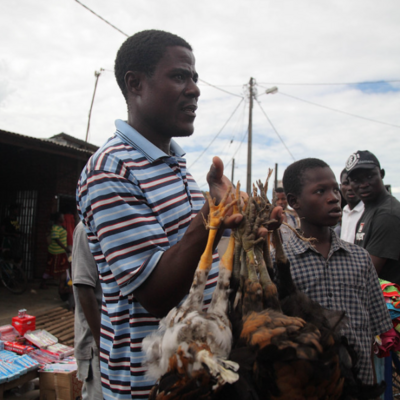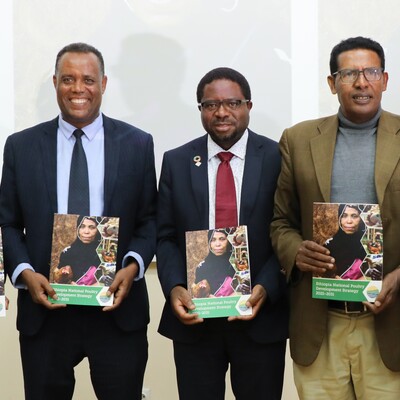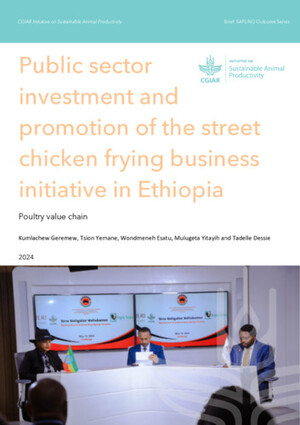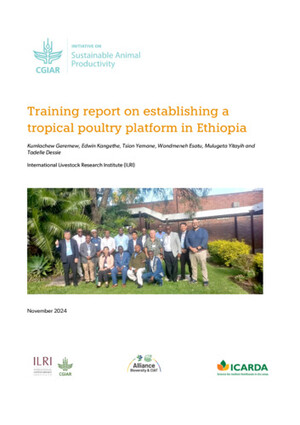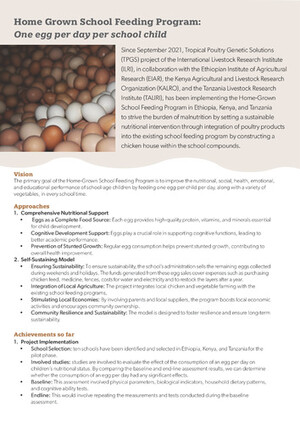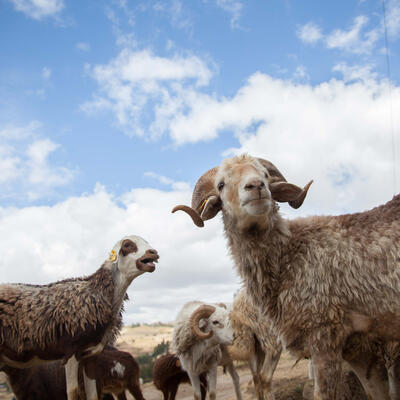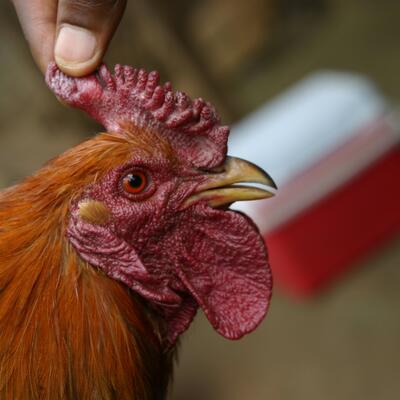
Voices on chicken genetics: Improving chicken breeds so rural households improve nutrition and income
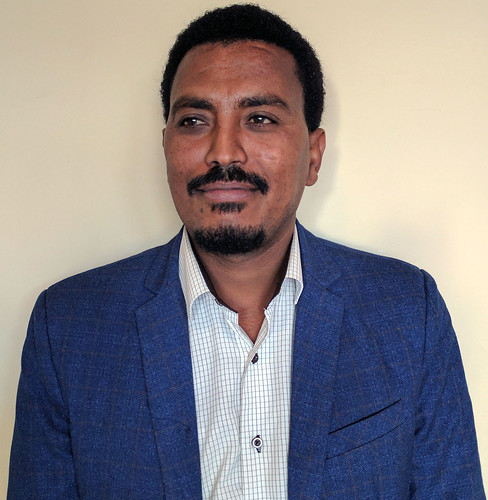
Shumye Belay is a sunbnational coordinator for the Africa Chicken Genetic Gains (ACGG) Project in Tigray, Ethiopia. (photo credit: ILRI / M. Tsegaye)
Shumye Belay is subnational coordinator for the Africa Chicken Genetic Gains (ACGG) Project in Tigray. He shares his interests and observations of the project in the following short interview. It is one of a series of portraits of key people in Africa Chicken Genetic Gains (ACGG).
Tell us about your background
I have a bachelor’s degree in animal science from Haramaya University and a master’s degree in livestock production and pastoral development from Mekelle University. I have spent the last 14 years working on livestock, first as livestock production expert at woreda (district) level and, for the past nine years, as livestock production researcher at regional level.
What is your function and what are you currently working to accomplish in ACGG?
As subnational coordinator for ACGG in Tigray, I oversee overall project activities that include planning, budgeting, data collection and staff management.
I am currently working on the distribution of the Kurolier and Sasso breeds we have received. We are also providing vaccinations and treatment for poultry. I believe that the biggest challenge which threatens the livelihood of farmers is diseases that attack their livestock. To address this challenge, we are providing information to farmers about the various diseases and how to prevent them. Farmers so far have been receptive to our messages, such as the need for improved chicken coops, which more than 95% of farmers in the project have constructed using locally sourced materials. But a significant number of them are still awaiting delivery of the Kurolier and Sasso chickens. In addition, all farmers are using feed supplements.
What in your role do you find most meaningful or engaging?
The focus on poultry itself is something that has always interested me. ACGG is the first project of its kind to specifically work on poultry. In the past, the focus has always been on the vast aspects of agriculture such as irrigation practices inputs and productivity. There has not been much attention on chicken production for small-scale farmers when in reality; it is a huge means of income generation for rural households. For example, the income that one chicken can help generate compared to one cow is incomparable. A farmer who has a local breed of chicken can get an average of 20 eggs a month, translating to about ETB 60 (USD 2.6), an amount that cannot be generated when there is shortage of feed or when a cow has low yield of milk.
I also think the focus on women is another interesting aspect of the project. ACGG recognizes their role in chicken production and is working towards their empowerment.
What is the next piece of work you are focusing on?
Our immediate objective is reducing the chicken mortality rate in Tigray region. Lack of awareness compounded by a shortage of professionals, has created a vacuum where vaccinating chickens or seeking medical care is concerned. We are tackling the issue by training government-organized cooperatives to provide veterinary services. We are also organizing new cooperatives in kebeles or localities that do not have them.
In addition to the ongoing collection of data and awareness creation with farmers, we are also planning on distributing the remaining three breeds to farmers.
What are some interesting research findings in ACGG in your region?
This is a relatively new project and we are still carrying out research. We have conducted a baseline study and are awaiting the release of results. We have also been facilitating innovation platforms. A qualitative observation that I have made while conducting these researches, and a unique one, is the immediate willingness of farmers to assist us with our research and their indication of the trust they have in us. I have had the privilege of visiting every farmer in the two woredas of Wuqro and Degantsehay and have seen the poultry houses they have constructed. Their hard work is very impressive and is a testament to how invested they are in our research systems and current as well as future findings.
What are some of the most intriguing or innovative research question that you want to explore in ACGG?
I would like to conduct research that would allow us to develop a new breed of chicken from our current local ones, much like other countries have succeeded in doing. The first and only locally and genetically improved Ethiopian breed is the Horro, but it can be improved still. The Horro breed is estimated to lay approximately 160 eggs per year but it can be improved to produce 300 eggs per year like some breeds. There are various breeds that are more productive and offer greater genetic potential but very little has been done in selection and breeding. In Tigray alone, for example, there are local breeds that provide choices in colour, weight and egg production such as the breed known as ‘Angete Melata’ or naked neck. I am interested in researching how specific breeds such as those can be genetically developed, not only to increase their output in egg production but to also improve their meat production.
What are you seeing as unique in your region?
The Tigray region is unique in the devastation and destruction it faced during the previous civil war. Tigray is now home to too many widows. While the government has designed programs to support them, one of ACGG’s project objectives is also empowering women and at least 30% of our participants are female headed households. However, I believe we should strive to work with 50%.
Anecdotal and scientific research also indicates that human nutrition is another area that requires prioritization in the communities of this region. And while the issue itself may not be unique to the region alone, the conditions within the region and the types of resources available to address the phenomenon grant it a unique status. The ACGG project was designed with the objective of also improving the communities attitudes towards, and understanding of, human nutrition. For example, farmers, both regionally and nationally, do not have a balanced diet but it is not always for lack of resources. Mothers have been known to sell eggs and then use the money to buy sweets for their children, proof of huge misconceptions around nutritional values offered by certain food groups.
What about the project causes concern for you and how could these be addressed?
We are awaiting the delivery of the remaining three chicken breeds. All of the project farmers have constructed the chicken coops and are waiting on us. We are planning to accelerate our efforts in distribution once we get the chickens to make up for the delay.
The other area of concern is the health of the chickens. As much as we have been working on educating farmers on how to best protect their poultry from disease, I am concerned about their ability to consistently comply with our recommendations regarding sanitation, proper housing and feeding, One way to address this concern is by working with the woreda veterinary professionals so they can assist us in orienting and maintaining dialogue with farmers. These professionals are more focused on ruminants so we plan to direct their attention to chickens. We also intend to use cooperatives to spread our messages because the number of veterinary experts might not suffice.
I believe that the major problem we face in the country is the lack of awareness on chicken production and it cannot be solved overnight. We work with the government to tackle this challenge and we will continue lobbying them to give more attention to chicken production and help us mobilize communities.
What do you foresee as the lasting impact of ACGG?
The lasting impact will revolve around the development of an improved breed. But developing new breeds is not a quick process. For example, the development of the Horro breed took a long time to accomplish. Therefore, by introducing already researched and improved breeds, we can directly move to production, thus benefiting farmers sooner. I also believe the major impact of the project lies in the development and addition of an improved breed that would be valuable to the country. An improved breed will have a long-term effect in profiting the society.
Any additional comments?
I am interested in developing breeds from the variety of breeds we already have. We have already started participatory community breed improvement for small ruminants in Ethiopia. I am interested in and recommend that we apply the same approach to chickens.
I would also like to say that the project should continue on doing additional research, demonstration and dissemination of chickens. I agree with Melinda Gates when she said ‘chickens are the ATM of the poor’. Using chickens as a means of generating income will be highly beneficial for the country.






